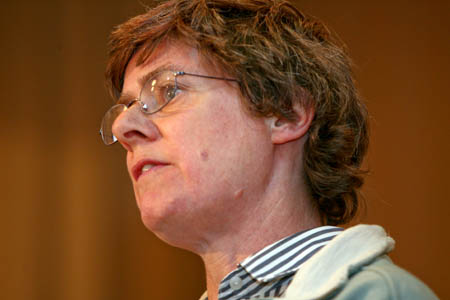
Kate Ashbrook: 'commons are magic'
Tomorrow will see the launch of a 21st century initiative to protect ancient open land which is under threat.
Public bodies have joined campaigners to produce a DVD which they hope will boost the profile of England’s common land and strengthen its protection, at a time when demand for space means ever more pressure on the green spaces which the country’s commons afford the public.
The video has been produced by Hampshire County Council, Hart District Council, Natural England and the Hampshire and Isle of Wight Wildlife Trust. It has the backing of the Open Spaces Society, Britain’s oldest campaigning group for green spaces.
The DVD, which will be released on Monday, 10 November, features views of village residents, along with explanations from English Heritage on the cultural importance of commons, which are a remnant of mediaeval rural practices.
Kate Ashbrook, general secretary of the Open Spaces Society, which was founded in 1865 to save the great commons around London from enclosure, said: “Four hundred years ago, half of England was common land, available for the benefit and pleasure of all. Today greed, intensive agriculture and development have reduced the commons to a mere three per cent.
“But concentrated into these remaining 1,544 square miles are vital reserves of land for wildlife and public access.”
Commoners often had the right to graze animals, collect wood or dig peat. Many of these have fallen out of use, but the most vital modern right is that to recreation – walking and in some cases horse riding – on common land which, contrary to an often mistakenly held belief, has an owner.
There are 7,062 separate commons in England, consisting of different terrain such as moorland or coastline.
Ms Ashbrook said: “The magic of the commons is that they are all open to public access on foot by law, and on some there are rights to ride. At the same time they are habitats for a fabulous variety of species. Everyone has a common near to where they live.
“The problem is how to defend them. On many it is essential to have animals grazing to prevent overgrowth by scrub, but the danger is that sheep or cattle will wander onto roads and be killed. Yet fences destroy the open freedom of the commons. We must look for other solutions and new compromises.”
Filming for the Common Vision DVD was carried out during May and June 2008 on several commons in the south, by an Orkney-based company.
“The video encourages communities to understand their commons and to care about them. Only by involving local people in their management can we hope to save them,” Ms Ashbrook adds.
English Heritage, the Department for Environment, Food and Rural Affairs and Defence Estates (Home Counties) have all supported the project. Limited numbers of the DVD will be available from Hampshire County Council for community groups and other organisations. The video will also be viewable later this month on the council’s website and that of the OSS.
- A new town green has been confirmed in the Shropshire town of Oswestry.
The county council’s registration committee upheld the decision by Vivian Chapman that five acres of land be declared a green. Mr Chapman made his recommendations following an inquiry in May this year.
The Open Spaces Society supported the claim by residents June McCarthy and Susan Davies that the land had been used by local people for 20 years.
Ms McCarthy said: “Before Oswestry Railway Land was registered, it had no protection. All the trees on it were felled, so the applicants hope that the community and schools will come together and work with the landowner, Advantage West Midland, the Council for the Protection of Rural England and Shropshire Wildlife Trust to plant trees and make the most of their new town green.”
Nicola Hodgson, the OSS’s case officer, said: “Mr Chapman’s decision could not be clearer. He recommended that the site should be registered as a green.
“This is thanks to the courage and persistence of the applicants and their supporters, who put in a well researched application and robustly defended challenges to the inspector’s recommendation by Advantage West Midlands and Cambrian Railways Trust.
“The recommendation was considered by Shropshire County Council’s registration committee on 4 November and the decision was made to register the land as a green.
“We congratulate all those involved who have enabled the land to be preserved for use by future generations of local people.”